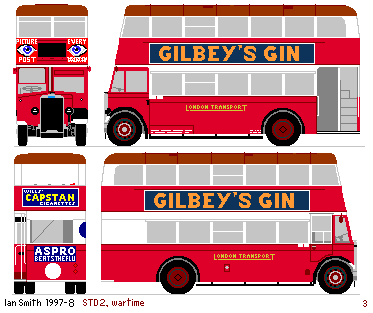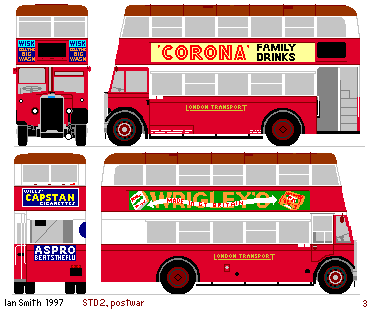
The LONDON TRANSPORT STDs
This page created December 1997 by Ian Smith, updated 14th October 1999

Contents
There were three distinct groups of STDs:
- The PreWar STDs: STD 1-100
- The austerity STDs: STD 101-111
- The PostWar STDs: STD 111-176

The War-time STDs: STD 101-111 (Total 11)
Introduced: 1941

Chassis: "unfrozen" Leyland Titan TD7, diesel engine, crash gearbox, coded 3STD.
These "unfrozen" chassis were a number that had been in course of construction when wartime restrictions halted bus production.
The exigencies of the domestic transport situation after the Blitz
caused the government to relent,
and allocate these now - finished chassis to various hard-pressed transport
authorities - London included.
So many places around the country received unfamiliar types of bus.
These TD7s had a shorter wheelbase than the 16ft 3in London standard.
Utility STD in original LT painted condition.
Body: Park Royal Utility, coded STD2. STD 101 carried the prototype Utility body.
Their utility bodies were to a Ministry of Supply specification,
with single skin construction; wooden frames; a single display (at the front);
and minimalist seating - all to conserve materials.
Oddly, they were taller than the London standard (14ft 6in rather than 14ft 3in),
which limited the garages they could be sent to.
They later acquired a second display above the platform, when passenger
enquiries about destinations slowed down bus-stop times significantly.
At first they also had a sheet metal emergency door at the rear upstairs.
These bodies were more familiar to Londoners on the later Guys and Daimlers
(and to a later generation on the Corgi model!).
The 3STD2s were allocated to Victoria garage (GM - for Gillingham Street),
but were not much appreciated either by the passengers
or those who had to work on them or with them.
A significant problem was that the heavy flywheel made gear changes slow,
so that journey times suffered.
Nevertheless they had to work routes suffering the worst of London's
stop-start traffic:
| Routes |
|---|
| 10: Abridge - Victoria Station |
| 22: Putney Common - Homerton |
| 77: Kings Cross - Tooting |
| 77A: Kings Cross - Raynes Park |
| 16: (Suns) West Hendon - Victoria Station |
| 137: Crystal Palace - Archway Stn |

They were modified as time went on:
they soon had side destination blinds fitted, as mentioned above.
At overhaul in 1945, (or 1948-9) the rear emergency door was replaced with a glazed one.
Also in 1945 they were fitted with a proper rear number plate,
to replace the plate on the platform partition, new headlamps,
and extra opening windows.
With proper ventilation now possible by the windows, the hopper ventilator
above the nearside front downstairs window was removed
(and the bulkhead strengthened).
Utility STD: retaining pre-war style livery after the War.
They remained in service until the beginning of February 1951,
when they began to be removed from GM after a staff ultimatum:
they had had enough of them!
They were sent to Potters Bar (PB) for storage,
all 11 reaching there by early May.
In October 1951 all 11 were taken out of store,
and used as staff buses to and from Aldenham (with fewer stops,
these duties were less of a problem).
In 1953 they were put to use as trainers,
becoming the last of the utility buses to be used by LT.
(Presumably LT thought that if learners could change gear on these,
they could do so on anything!)
They found no buyers, unlike the other utilities,
and had all gone for scrap by September 1955.

 bus histories bus histories
 photo references photo references

 Ian's Bus Stop Ian's Bus Stop
 prewar STDs prewar STDs
 war-time STDs war-time STDs
 postwar STDs postwar STDs

|